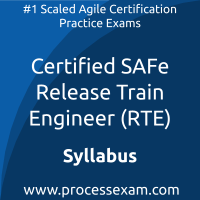 To achieve the professional designation of SAFe Release Train Engineer from the SAFe, candidates must clear the RTE Exam with the minimum cut-off score. For those who wish to pass the SAFe Release Train Engineer certification exam with good percentage, please take a look at the following reference document detailing what should be included in SAFe Release Train Engineer Exam preparation.
To achieve the professional designation of SAFe Release Train Engineer from the SAFe, candidates must clear the RTE Exam with the minimum cut-off score. For those who wish to pass the SAFe Release Train Engineer certification exam with good percentage, please take a look at the following reference document detailing what should be included in SAFe Release Train Engineer Exam preparation.
The SAFe RTE Exam Summary, Sample Question Bank and Practice Exam provide the basis for the real Certified SAFe Release Train Engineer (RTE) exam. We have designed these resources to help you get ready to take SAFe Release Train Engineer (RTE) exam. If you have made the decision to become a certified professional, we suggest you take authorized training and prepare with our online premium SAFe Release Train Engineer Practice Exam to achieve the best result.
SAFe RTE Exam Summary:
| Exam Name | SAFe Release Train Engineer |
| Exam Code | RTE |
| Exam Fee |
First attempt is included in the course registration fee if taken within 30 days of course completion. Each retake or attempt past the 30-day window is $50. |
| Exam Duration | 120 Minutes |
| Number of Questions | 60 |
| Passing Score | 78% |
| Format | Multiple choice (one answer) or multiple select (2-3 answers) |
| Books / Trainings | Training Class |
| Schedule Exam | SAFe |
| Sample Questions | SAFe Release Train Engineer Exam Sample Questions and Answers |
| Practice Exam | Certified SAFe Release Train Engineer (RTE) Practice Test |
SAFe Release Train Engineer Syllabus Topics:
| Topic | Details | Weights |
|---|---|---|
| Exploring the RTE Role |
- RTE Characteristics and Responsibilities - SAFe Concepts |
15-17% |
| Applying SAFe Principles |
- Preparation Activities - Facilitation Activities - Planning Development - Multi-location Facilitation |
21-24% |
| Executing the PI |
- ART and Team Iteration Events - Optimizing ART Flow - Metrics - IP Iteration - Inspect and Adapt Event |
27-29% |
| Serving the ART |
- Key ART Roles and Responsibilities - Release on Demand - Systems Thinking and Value Stream Mapping - Facilitation and Coaching Techniques - One-Team Culture |
30-32% |
Both SAFe and veterans who’ve earned multiple certifications maintain that the best preparation for a SAFe RTE professional certification exam is practical experience, hands-on training and practice exam. This is the most effective way to gain in-depth understanding of SAFe Release Train Engineer concepts. When you understand techniques, it helps you retain SAFe Release Train Engineer knowledge and recall that when needed.
